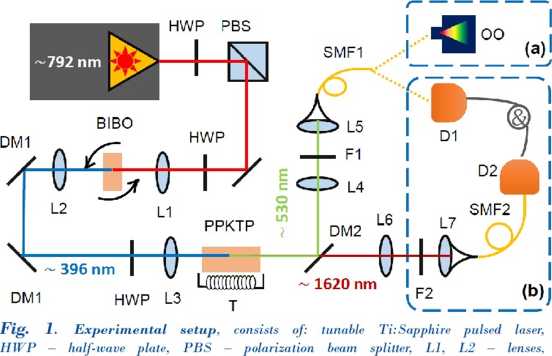1496129306
Measuring dispersion in nonlinear crystals
beyond detectors’ speetral rangę

Marta Misiaszek, Andrzej Gajewski, Piotr Kolenderski
National Laboratory of Atomie, Molecular and Optical Physics,
Institute of Physics, Faculty of Physics, Astronomy and Informatics,
Nicolaus Copernicus University in Toruń

photon wavelength [nm]
Fig. 3. Effective refractive index. Shaded fields correspond to areas with the quasi phase matching condition fulfilled. Inset: dijferences between literaturę and simulated data.
Proper characterization of nonlinear crystals is essential for designing single photon sources.
Here we show a techniąue for dispersion characterization of a nonlinear materiał by making use of phase matching in the process of parametric down conversion. Our method is demonstrated on an exemplary PPKTP (periodically poled potassium titanyl phosphate) crystal phase-matched for S96nm to 532nm and 1550nm.We show a procedurę to determine the dispersion in the rangę of (390,1800) nm by using only one spectrometer for the UV-visible rangę.

BIBO — nonlinear crystal, DM1 — dichroic mirror, L3 — lens, PPKTP — nonlinear crystal, T — temperaturę controller, DM2 — dichroic mirror, L4 — lens, FI — set of filters, L5 — asplieric lens, L6 — lens, F2 — long-pass filier, L7 — aspheric lens. Detection setups: a) 00 — commercially atailable spectrometer, b) Dl, D2 — single photon detectors.
Experimental results
The pump photon wavelength is set in the rangę of (392, 403) nm for crystal temperaturę equal to 304.8 K. For each of the settings a spectra of the visible photon and pump photons are measured. The central wavelengths of both the photons are depicted in Fig. 2 (green dots). An exemplary spectrum measurement is shown as an inset.
Theoretical modelling
The main goal of modelling is to obtain effective refractive index in nonlinear crystal by determining the Sellmeier coefFicients (a, bi, c{). It is given by
nlff{X) = a + y^Pf
i
JL
sad
|>hnl<m wayeliMiglh [lim]
experimental data simulated data literaturę data
a 520 1 510
pump photon wavelength [nm]
Fig. 2. Experimental results, uisible photon warelength dependence on the pump wauelength. Inset: an exemplary measurement of a visiblephoton spectrum.
In the SPDC proces the ąuasi phase - matching is given by
2n
Ak = kp± - ks± -ki±- — = 0.
This relations allows us to determine all three photons’ wavelengths, by measuring only two of them. Also, it allows to extract Sellmeier coefficients for the photon which is not measured directly.
Our algorithm consists of the following steps:
1. choose some initial (literaturę) coefficients,
2. check the phase matching condition, calculate photon wavelengths,
3. compare obtained wavelenghts with experimental ones, change slightly coefficients and return to step 2.
The experimental, literaturę and simulated data is shown in Fig 2. The goodness of fit to the experimental data for literaturę effective refractive index is eąual to %2 = 5.44, whereas for our simulated one is*2 a 1.72.
Funding Information
The authors acknowledge support by the National Laboratory FAMO in Toruń, Poland, fmancial support by Foundation for Polish Science under Homing Plus no. 2013-7/9 program supported by European Union under PO IG project and by Polish Ministry of Science and Higher Education under grant 6576/IA/SP/2016 and Iuventus Plus grant no. IP2014 020873.

European Funds
Smart Growth

Foundation for Polish Science
European Union I
European Regional I Development Fund |
NV
Ministry of Science and Higher Education
Republicof Poland

Wyszukiwarka
Podobne podstrony:
00232 ?9b1ac6d3646bcdf4e254edd2dae625 234 Baxley Choosing menu option #5 results in an individual a
img024 Motor Control Rałionale Biblioaraphy Berg, K., et al., 1989 Measuring balance in the elderly:
BIOLOGICAL AEROSOL MEASUREMF.NT IN DAIRY PLANTS of nitrogen and ozonc are produced which may be loxi
A J2EE based server for Muon Spectrometer Alignment monitoring in the ATLAS detector Journal of
pulse-width - szerokość impulsu ąuartz - kwarc quartz crystals - kryształy kwarcu rangę - pasmo rati
img40 Coordination #Mass Fractal Dimension Nanoerystals in the powder, alike atoms in the crystal la
THE NEW MEASUREMENT STANDS IN ACREDITED ACOUSTIC LABORATORY OF ITB GROUP OF RESEARCH LABORATORIES Su
Replication Solutions Replication can be used in many different environments for a rangę of purposes
30 (272) 30• THE PATTERN COLLECTIONBabylacet Using Coats Chain Mercer Crochet No. 40, the edging mea
32 (250) 32•THE PATTERN COLLECTIONBo Peep Using Coats Chain Mercer Crochet No. 60, the edging measur
9 (668) THE PATTERN COLLECTION»9Beaded Braid Using Coats Chain Mercer Crochet No. 20, the tatting me
infrared body?tector INFRA-RED BODY DETECTOR - M3)T SffWTMn) THE circuit in Fig.2 can detect any lar
2. Measure toe-in. FrontCHASSIS AND BODY MAINTENANCE _Checking Wheel Alignment (Cont d)_ Lines paral
MYOPS 252002 i i i 1 ♦ i i * I 1 * « { i i 2. Fold it in half.Crystal Star 1. Cut out design on dott
72202 img024 Motor Control Rałionale Biblioaraphy Berg, K., et al., 1989 Measuring balance in the el
settings were performed laboratories as described in manuscript. second detector of the AmCyan
Movable In-Core Neutron Detectorspwr/phwrFission Chambers Ex-Core Fission Chambers •
więcej podobnych podstron